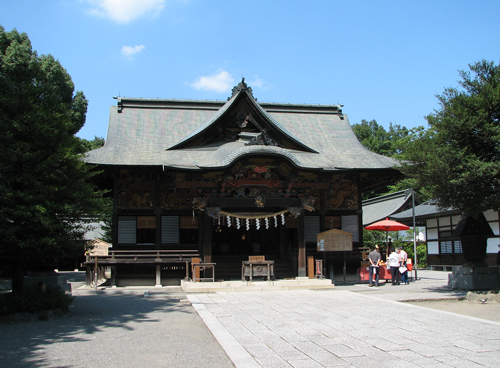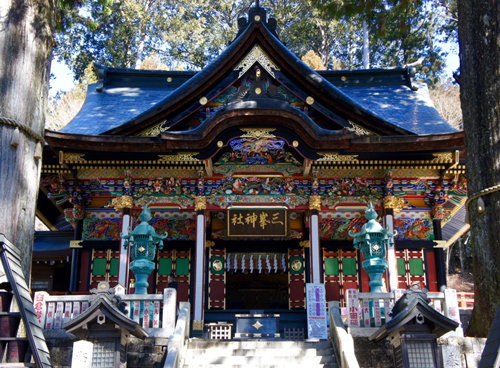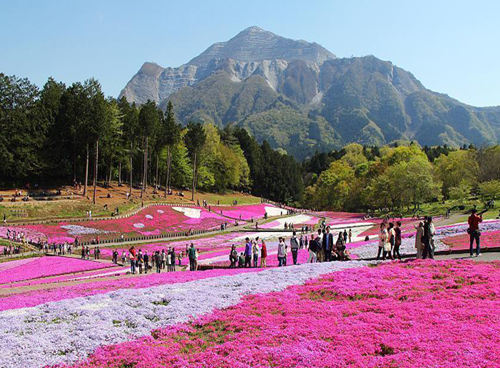
Chichibu Shrine
Chichibu shrine also known as the home of the Chichibu Night festival that takes place every December. The shrine is said to be around 1000 years old built in 1592. The complex is surrounded by trees, making for a peaceful atmosphere in the middle of the city. Banbacho, a street filled with traditional Japanese goods, souvenirs and food is followed up to the shrine. Many of the banbocho’S buildings are 100 years old and the perfect blend of the western and Japanese architecture that makes this place worth a visit.

Mitsumine Shrine
Sitting atop the 1,110 meter-high Mt. Mitsumine, this ancient site of mountain asceticism certainly deserves all the fame. Unlike with most other Shinto sites, the shrine’s consecrated grounds are protected by wolves who were believed to be of divine nature in years gone by. Unfortunately, a visit to this remote site is a day trip in and of itself so if you want to include it in your Chichibu itinerary, you’ll need to overnight somewhere nearby. It is easily accessible by bus or car, but tourists who prefer the more active route can reach it by hiking. The most interesting thing about Mitsumine Shrine is that it is a rare shrine that worships the now-extinct Japanese wolves, who have been considered as guardians against misfortune.

Sea of Clouds
Also known as “Unkai” in Japanese, this atmospheric phenomenon occurs when the cloud cover becomes so thick and rolling that it is like an ocean. Though Mt. Fuji is often considered to be Japan’s most famous site of Unkai, thanks to Chichibu’s mountainous terrain, the area’s Minoyama park is also a spectacular site (as can be seen in the above photo). From what I can gather, the best times to witness this natural spectacle are in April and November.
Seasonal Attractions

Hitsujiyama Park
This park in Chichibu known for its beautiful pink fields that typically come into bloom around late April to early May and attract droves of visitors. The Hill of Pink Moss fields are located at the southern end of the park and have multiple types of moss pink (or Shibazakura) spread over the undulating fields to give them hues of pink, purple and white. The flowers have been planted strategically to make colorful patterns that make for quite the display.

Chichibu Night Festival
Chichibu Night Festival is the most famous festival in the Kanto Region of Japan. It takes place on the 2nd and 3rd December of every year. Its a fireworks festival held at Chichibu Shrine. It is considered as part of the top three Japanese festivals that feature floats. Its floats are ornately decorated with lanterns, tapestries, and gilded wood carvings and are accompanied by drum and flute music. The festival’s other attraction is its fireworks display, which lasts almost two and a half hours and gives you the rare opportunity to enjoy Japanese fireworks during winter. Additionally, the streets are lined with stands selling festival foods and amazake (sweet rice wine) to combat the cold December night.

Icicles of Misotsuchi
One of the most magical you can witness in Japan is here in Chichibu. Icicles of Misotsuchi is a combination of a natural phenomenon and human ingenuity produces an otherworldly sight. As temperatures drop and frigid winds blow, the spring water freezes solidly on the rock face and over time transforms into a collection of enormous icicles. Local residents created the site more magical by setting up an ingenious series of lights that shine upon the frosty spears. This causes the color of Misotsuchi’s icicles to gradually shift from white to blue to green. As the hues change, their reflections on the icy stream below create a hauntingly bleak sight that redefines the very meaning of cold. If you’re looking for an awesome winter photo, know that the illuminations run between 5:00 PM and 9:00 PM during January and February.
